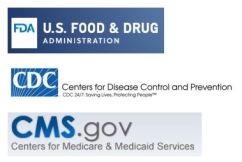News & Views: 2019 Opioid Agenda, Quality for Continuous Manufacturing, Task Force for Public Health Emergencies, Brain Computer Interface devices, Quantifying Oncology Patient Experience
2019 policy and regulatory agenda for continued action to forcefully address the tragic epidemic of opioid abuse
New actions to build on 2018 efforts and also adapt to changing nature of threat
- Reducing Misuse and Abuse of Opioid Drugs: Appropriately prescription, dose, quantity, treatment duration, disposal, REMS effectiveness
- Support Addiction Recovery and Reduce Overdose Deaths: OTC naloxone with model Drug Facts Labels with easy directions for use
- Research and Innovation in Non-Addictive Pain Treatments: Non-opioid drugs, abuse-deterrent features
- Strengthen Enforcement Against Illicit Opioids: Partnership with U.S. Customs and Border Protection
 Quality Considerations for Continuous Manufacturing
Quality Considerations for Continuous Manufacturing
Continuous technology is foundation for improving overall quality of products and availability to patients
- Integrated process with fewer steps , shorter processing times, smaller equipment footprint, enhanced development approach e.g., quality by design (QbD) and use of process analytical technology (PAT)
Quality considerations
- Key Concepts: Process dynamics, Defining batches for continuous manufacturing processes
- Control Strategy: Input material, Process monitoring, Material diversion, Real Time Release, Specification, Equipment, System integration, Data processing, and Management
- Process Validation: Stage 1 – Process Design, Stage 2 – Process Qualification, Stage 3 – Continued Process Verification
- Additional Pharmaceutical Quality System Considerations: Scale-Up, Stability, Bridging existing batch to Continuous Manufacturing
- data storage and handling from process analytical technology systems
- potential approaches for situations where direct attribute measurement is not possible (e.g., low dose compounds)
- contract manufacturers employing continuous manufacturing
- risk-based reporting of routine model maintenance and updates
- statistical approaches using large samples (e.g., Large N)

FDA, CDC, and CMS launch task force to help facilitate rapid availability of diagnostic tests during public health emergencies
The Tri-Agency Task Force for Emergency Diagnostics (TTFED)ompsed of FDA + CDC + CMS
- Collaborate on future emergency diagnostic response needs
- Convene, provide timely recommendations to laboratories for rapid implementation of FDA’s Emergency Use Authorization (EUA) assays
Focus to
- establish efficient communication channels between TTFED members
- formalize and document interagency process for rapid implementation of EUA IVD assays in public health emergency
- provide timely recommendations during emergencies

Implanted Brain-Computer Interface (BCI) Devices for Patients with Paralysis or Amputation – Non-clinical Testing and Clinical Considerations
Implanted BCI devices have potential to bring benefit to people with severe disabilities by increasing their ability to interact with their environment, and consequently, providing new independence in daily life
- Implanted BCI devices are neuroprostheses that interfaces with central or peripheral nervous system to restore lost motor and/or sensory capabilities in patients with paralysis or amputation
Pre-Submission/IDE recommendations:
- Device description
- Software
- Biocompatibility
- Sterility
- Pyrogenicity
- Shelf life and packaging
- Electrical safety and Electromagnetic compatibility
- Wireless technology
- Magnetic resonance compatibility
- Non-clinical bench testing
- Risk analysis
- Electrodes
- Leads and connectors
- Implanted casing and electronics
- Output simulation measurements
- Output stimulation safety
- Programmrrs/control unit
- Radiofrequency transmitter and receiver
- System level testing
- Referencing Master Files
- Animal testing scope
- Clinical study considerations

Oncology Center of Excellence — Quantifying the Patient Experience
Collaboration between FDA Centers and external stakeholders involved in patient outcomes research in cancer populations
- Actively engaging with patients and advocacy groups
- Fostering research into measurement of the patient experience
- Generating science-based recommendations for regulatory policy
Goals to assess patient experience that complement existing survival and tumor information
- Learning from Patient Experiences
- Collaborating with Patients, Public and Private Sectors
- Fostering Continued Engagement
Image credit: CMS, FDA
